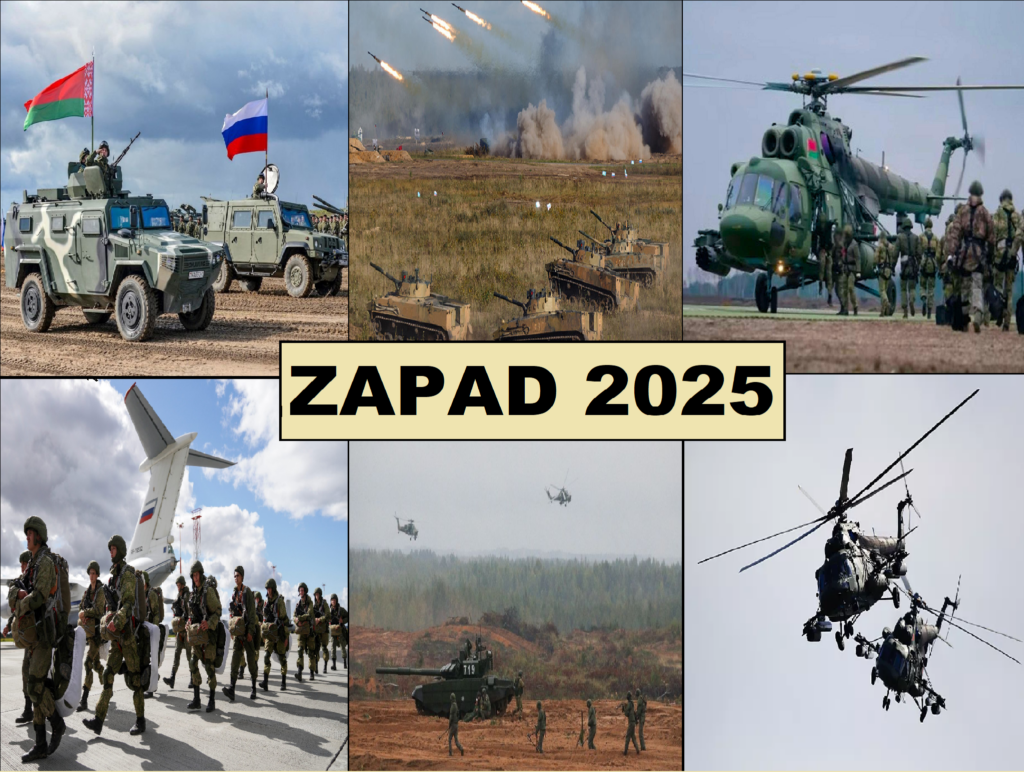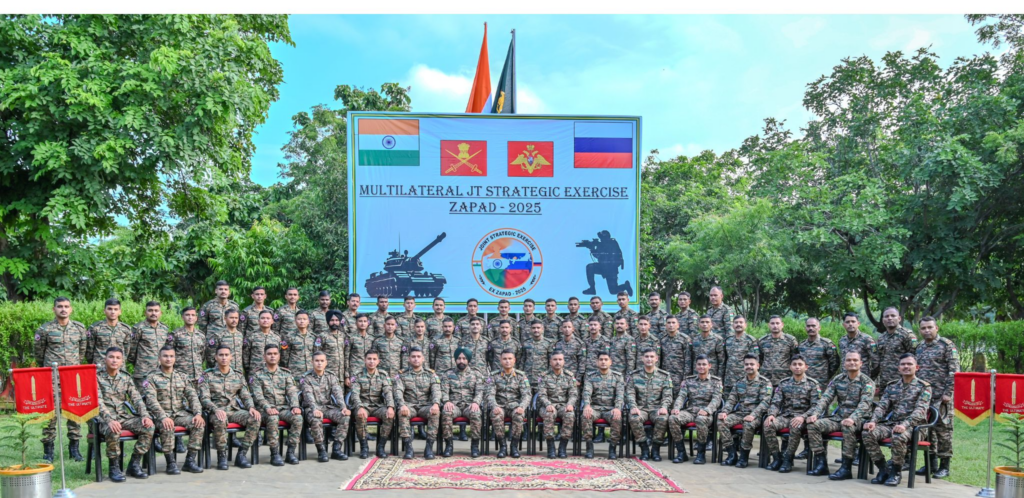
- Zapad has evolved from a purely conventional Soviet-style exercise into a multi-dimensional operation incorporating cyber and electronic warfare, space assets, drone technologies, and tactical nuclear scenarios.
- The exercises centre on force-on-force manoeuvres simulating mechanised warfare against a NATO-style adversary.
- The exercise blends battlefield experimentation with strategic messaging, showcasing Russian capabilities across land, air, cyber, and nuclear domains while provoking regional security reactions and recalibrating geopolitical balances.
- Zapad-2025 is more than a military drill for India; it is a clear strategic statement of multi-alignment and independent power projection in a fractured world order.
Zapad (Russian for “West”) is one of the most prominent fixtures on Russia’s military calendar. First held in 1981 during the Cold War as a massive Soviet exercise against NATO, it was revived in the late 1990s after the collapse of the USSR and now takes place every four years. Co-hosted by Russia and Belarus, Zapad serves both as a large-scale military rehearsal and a geopolitical signal, closely watched by allies and adversaries alike.
Over time, Zapad has evolved from a purely conventional Soviet-style exercise into a multi-dimensional operation incorporating cyber and electronic warfare, space assets, drone technologies, and tactical nuclear scenarios. Its scale—often exceeding 100,000 troops—regularly impacts European security calculations.
The 2025 edition saw diverse participation. Russia and Belarus led the drills, testing interoperability and regional defence strategies. India joined as a full participant, while Pakistan and Türkiye sent observers. Notably, the United States also dispatched military observers, underscoring the exercise’s strategic weight. Meanwhile, NATO members Poland, Lithuania, and Latvia conducted parallel counter-exercises and tightened airspace controls, reflecting persistent mistrust surrounding Zapad’s intentions.
| Category | Participants |
|---|---|
| Core Participants | Russia (host), Belarus (host), India, Armenia, Kazakhstan, Kyrgyzstan, Tajikistan (CSTO members) |
| Observer States | United States (NATO), Turkey (NATO), Hungary (NATO), China, Iran, Mongolia, Pakistan, Uzbekistan |
India’s Participation in Zapad-2025
India’s participation in Zapad-2025 carries both symbolic and strategic weight. For decades, India has maintained close defence ties with Russia, ranging from advanced arms supplies to joint projects like the BrahMos missile. By sending a contingent, New Delhi reaffirmed this partnership while simultaneously deepening ties with the U.S., France, and other Western allies.
For the Indian military, the exercise offers insight into Russian doctrine, hybrid warfare simulations, and cold-weather training relevant to its northern borders. Broadly, India’s presence signals its pursuit of strategic autonomy and aligning with multiple blocs without binding itself to any.

Amid escalating U.S.–Russia tensions, India demonstrates its ability to maintain balanced relations, acting as a global swing state that preserves defence interoperability with Russia while cooperating with Western partners in the Indo-Pacific. Officially, India frames its involvement as “professional and non-political,” consistent with its tradition of participating in multinational exercises.
In essence, Zapad-2025 is more than a military drill for India; it is a clear strategic statement of multi-alignment and independent power projection in a fractured world order.
First held in 1981 during the Cold War as a massive Soviet exercise against NATO, it was revived in the late 1990s after the collapse of the USSR and now takes place every four years.
Multi-Domain Military Exercises
Zapad-2025, jointly conducted by Russia and Belarus, is one of the largest multi-domain military exercises, aimed at validating operational preparedness, strategic planning, and combined arms coordination under high-intensity conflict scenarios.
Conventional Operations: The exercises centre on force-on-force manoeuvres simulating mechanised warfare against a NATO-style adversary. Armoured brigades with T-72B3, T-90M, and T-14 Armata tanks advance alongside mechanised infantry in BMP-3 IFVs and BTR-82A APCs. Artillery systems, such as the 2S19 Msta-S, BM-30 Smerch, and Iskander-M, provide long-range fire support, enabling rapid shifts between offensive and defensive operations. Air defence is layered with S-400s, Pantsir-S1 systems, and Su-35S/Su-30SM fighters, backed by radar and electronic warfare networks. Airborne and amphibious forces conduct rapid insertions to seize key terrain like bridges and airfields, testing joint force projection and coordination.
Hybrid, Cyber, and Electronic Warfare: The hybrid warfare component trains troops for urban combat against irregular forces, including building clearance, infrastructure defence, and psychological operations. Cyber and electronic warfare units conduct offensive and defensive operations—jamming communications, spoofing GPS, and attacking command networks—to ensure electronic dominance and resilience in high-tech conflict.
Drones and Autonomous Systems: New features include UAV swarms for reconnaissance and precision strikes, and integration of unmanned ground vehicles with manned units. These experiments enhance situational awareness, reduce personnel risk, and test future combat integration.
Nuclear Planning: Tactical nuclear scenarios involve tabletop and field exercises using systems like Oreshnik missiles. These drills refine command-and-control procedures and integrate nuclear options into conventional planning, reinforcing deterrence and signalling strategic intent.
Joint and Coalition Operations: The exercises merge Russian and Belarusian commands while involving foreign participants and observers, testing interoperability and coalition command skills. Simultaneously, NATO conducts counter-exercises—such as Poland-Lithuania border drills and Baltic Air Policing—to assess rapid mobilisation and deterrence. This interplay provides both sides with insights into offensive and defensive strategies.
| Cateogry | Weapons/Systems |
|---|---|
| Armoured & Ground Forces | T-72B3, T-90, T-14 Armata |
| BMP-2, BMP-3 | |
| BTR-82A, MT-LB | |
| 2S19 Msta-S, BM-21 Grad, Mortars | |
| Air Defence Systems | S-400 Triumf, S-300 |
| Pantsir-S1 | |
| Aircraft | Su-35S, Su-30SM, MiG-29 |
| Su-25 | |
| Il-76, An-124 | |
| Ka-52, Mi-28, Mi-8 | |
| Missile Systems | Oreshnik Tactical Missile |
| Iskander-M | |
| BM-21 Smerch | |
| Unmanned & Autonomous Systems | Orlan-10, Forpost UAVs |
| Autonomous Ground Vehicles (UGVs) | |
| Electronic & Cyber Warfare | Krasukha, Leer-3 |
| Cyber tools | |
| Infantry & Small Arms | AK-74M, AK-12 |
| PKP Pecheneg | |
| RPG-7, RPG-32 | |
| Sniper rifles, grenade launchers |
President Vladimir Putin attended the final stage of Zapad-2025 at the Mulino training area, highlighting its aim of providing ‘absolute protection’ to the Russia-Belarus Union State.
Putin’s Visit & Strategic Signals
President Vladimir Putin attended the final stage of Zapad-2025 at the Mulino training area, highlighting its aim of providing “absolute protection” to the Russia-Belarus Union State. The exercise, involving 100,000 troops and advanced weaponry, reflected lessons from Ukraine and showcased both Russia’s deterrence—through tactical nuclear training—and its resource strains from ongoing conflicts.
NATO members Poland, Lithuania, and Latvia reacted with border closures, tightened airspace control, and large counter-manoeuvres under “Iron Defender.” Their response reinforced Zapad-2025’s role in reshaping geopolitical balances.

Conclusion
Zapad-2025 blends battlefield experimentation with strategic messaging, showcasing Russian capabilities across land, air, cyber, and nuclear domains while provoking regional security reactions and recalibrating geopolitical balances.
Zapad-2025 ultimately functioned as both a complex military exercise and a potent geopolitical message. It showcased Russia’s evolving warfighting capabilities across multiple domains while drawing in a diverse set of participants and observers, including India, whose involvement reflected its nuanced strategic posture. At the same time, NATO’s counter-exercises and regional responses underscored enduring fault lines in European security. Together, these dynamics reveal Zapad not just as a rehearsal for conflict but as a stage where military preparedness, strategic signalling, and global power alignments converge.
References:
- https://tass.com/world/2017443
- https://en.wikipedia.org/wiki/List_of_Zapad_exercises
- https://europeanleadershipnetwork.org/commentary/not-so-quiet-on-the-western-front-why-russias-zapad-exercise-highlights-the-need-for-military-confidence-building-measures/
- https://www.aljazeera.com/news/2025/9/16/india-joined-belarus-russia-war-games-amid-signs-of-rift-with-us
- https://dgap.org/en/research/publications/zapad-2025-and-russias-war-planning
- https://tass.com/politics/2023251/amp
- https://www.newsonair.gov.in/india-participates-in-russia-led-zapad-2025-military-exercise-with-65-armed-forces-personnel/
- https://www.pib.gov.in/PressReleasePage.aspx?PRID=2164916
Piyush Anand is a Biotechnology Engineering student at Chandigarh University. His primary interest lies in International Affairs, Defence and Strategy. Views expressed are the author’s own.
